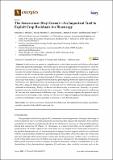Por favor, use este identificador para citar o enlazar a este item:
http://hdl.handle.net/10261/202433COMPARTIR / EXPORTAR:
 SHARE SHARE
 CORE
BASE CORE
BASE
|
|
| Visualizar otros formatos: MARC | Dublin Core | RDF | ORE | MODS | METS | DIDL | DATACITE | |

| Título: | The Senescence (Stay-Green)—An Important Trait to Exploit Crop Residuals for Bioenergy |
Autor: | Munaiz, Eduardo D.; Martínez, Susana; Kumar, Arun; Caicedo Villafuerte, Marlon Brainer CSIC ORCID; Ordás López, Bernardo CSIC ORCID | Palabras clave: | Stay-green Senescence Bioenergy Breeding High-throughput phenotyping Quantitative genetics Genetics Chlorophyll Maize and rice |
Fecha de publicación: | 2020 | Editor: | Multidisciplinary Digital Publishing Institute | Citación: | Energies 13(4): 790 (2020) | Resumen: | In this review, we present a comprehensive revisit of past research and advances developed on the stay-green (SG) paradigm. The study aims to provide an application-focused review of the SG phenotypes as crop residuals for bioenergy. Little is known about the SG trait as a germplasm enhancer resource for energy storage as a system for alternative energy. Initially described as a single locus recessive trait, SG was shortly after reported as a quantitative trait governed by complex physiological and metabolic networks including chlorophyll efficiency, nitrogen contents, nutrient remobilization and source-sink balance. Together with the fact that phenotyping efforts have improved rapidly in the last decade, new approaches based on sensing technologies have had an impact in SG identification. Since SG is linked to delayed senescence, we present a review of the term senescence applied to crop residuals and bioenergy. Firstly, we discuss the idiosyncrasy of senescence. Secondly, we present biological processes that determine the fate of senescence. Thirdly, we present the genetics underlying SG for crop-trait improvement in different crops. Further, this review explores the potential uses of senescence for bioenergy crops. Finally, we discuss how high-throughput phenotyping methods assist new technologies such as genomic selection in a cost-efficient manner. | Descripción: | © 2020 by the authors. | Versión del editor: | https://doi.org/10.3390/en13040790 | URI: | http://hdl.handle.net/10261/202433 | DOI: | 10.3390/en13040790 | E-ISSN: | 1996-1073 |
| Aparece en las colecciones: | (MBG) Artículos |
Ficheros en este ítem:
| Fichero | Descripción | Tamaño | Formato | |
|---|---|---|---|---|
| Senescence_Munaiz_Art2020.pdf | 1,26 MB | Adobe PDF |  Visualizar/Abrir |
CORE Recommender
SCOPUSTM
Citations
13
checked on 17-abr-2024
WEB OF SCIENCETM
Citations
12
checked on 14-feb-2024
Page view(s)
151
checked on 19-abr-2024
Download(s)
137
checked on 19-abr-2024
Google ScholarTM
Check
Altmetric
Altmetric
Este item está licenciado bajo una Licencia Creative Commons

